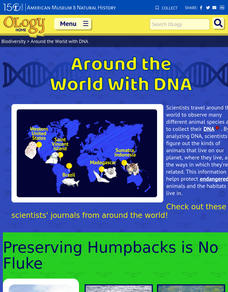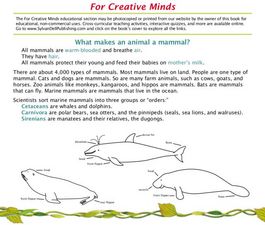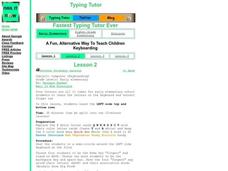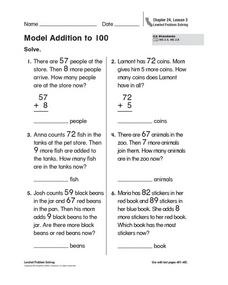Omaha Zoo
Monitoring Amphibians
What sort of shoes do frogs wear? Open toad sandals. If your scholars want experience collecting field samples, this is the lesson for you. After learning the proper way to collect field samples, pupils catch amphibians to test for...
American Museum of Natural History
Being a Zoologist: Sandra Olsen
Are your students wild about horses? Then introduce them Sandra Olsen, a zooarchaeologist, who has been studying horses and the people who herd them. Ms Olsen responds to 15 interview questions and details how she goes about her...
Curated OER
Dictionaries
Introduce your budding readers to the dictionary. They read a brief introduction on dictionary features, observing pictures and examples of one-syllable words they could find in a dictionary. Using the word list, they determine which...
University of California
Plankton
Plankton: so much more than just a SpongeBob character. Three different activities have kids looking at both phytoplankton and zooplankton in pictures, as well as collecting their own samples (depending on your access to a saltwater...
British Council
Alphabet
Here's a packet filled with suggestions and activities for teaching the alphabet.
Curated OER
Camel Container: Ceramics
Play with clay while building finger dexterity and important sculpting techniques. Learners make camel containers while they practice throwing and molding clay. Fun camel facts make this an interdisciplinary art lesson.
Curated OER
Third Grade Math
In this math worksheet, 3rd graders complete multiple choice questions about fractions, evens and odds, decimals, and more. Students complete 20 questions.
Curated OER
Introduce Vocabulary: Over in the Meadow (Keats)
If you're reading the classic story Over in the Meadow, consider this strategy to cover vocabulary in context with budding readers. After a brief introduction, listeners raise a hand when they hear each word (bask, burrowed, and cawed)...
E Reading Worksheets
Idioms Test
How well do your class members understand the figurative meaning of idioms? Find out with this 15 question multiple choice assessment.
Curated OER
Bottled Water Ban
Convenience, taste, portability ... what's not to love about bottled water? Apparently, a lot. Scholars analyze the four main arguments supporting and opposing the sale of bottled water. They explore the health, environmental, and...
American Museum of Natural History
Going, Going...Gone?
Young environmentalists consider how scientists are attempting to save endangered species. They read about what causes extinction and steps to take to minimize the threats.
American Museum of Natural History
Around with World with DNA
A mammalogist, ornithologist, ichthyologist, and a conservation geneticist share their work and their hopes that their research will help protect and save endangered species and their habitats.
Curated OER
Number Song
Students sing a song (to the tune of The Twelve Days of Christmas) that helps reinforce their counting skills.
Curated OER
For Creative Minds: What Makes an Animal a Mammal?
Students read about categories of mammals and their features. Students then construct a marine animal, using given print outs in the activity. Students then create adaptations for their mammal, using a web site reference for guidance.
Curated OER
Intermediate Sentence Completion: 12
In this sentence completion learning exercise, students fill in the blank for the correct word for each sentence. Students complete 10 multiple choice questions. Click on "show all" to see the rest of the learning exercise.
Curated OER
Computer (Keyboarding)
Have your class play a game in which they practice identifying various keys on a keyboard by moving around on a body-sized model keyboard. Kids love this game!
Curated OER
Model Addition to 100
In this addition instructional activity, students solve 6 word problems using the numbers 1-100. The first 2 problems are set up as a guide.
Curated OER
Finding Your Way in the World Wide Web
Researchers practice grouping items to explore the concept of a database. They apply these concepts to the WWW search engine format and consider why it is important to enter the most specific information.
Curated OER
Module 1, Unit 2, Lesson Plan 2: PCR and DNA Diagnosis
High schoolers discuss the importance of the Polymerase Chain Reaction for biologists. They explain what factors make the Polymerase Chain Reaction possible. Students explain the steps in thermocycling and what happens during each step.
Curated OER
Cloudy With a Chance of Meatballs
Fourth graders participate in a play to work on seeing events from a different perspective. Some of them are reporters, some cameramen and women, and others are interviewed. They put themselves in the shoes of the people in the book...
Curated OER
The Kingdoms
Students review the various categories in taxonomy. In groups, they identify the characteristics of each kingdom and compare and contrast them. They define the terms binomial nomenclature and morphology. To end the lesson, they create...
Curated OER
Species Charades
Students identify endangered species. In this endangered species lesson, the teacher leads a discussion about endangered species, then the class plays a game of charades to pantomime animal behavior.
Curated OER
Sun, Sand, and Hippos
Students conduct research on varied aspects of hippopotamuses and in doing so, synthesize and evaluate a variety of information sources.They summarize content knowledge from varied resources and apply this knowledge by creating a mural...
Curated OER
Addition Exercises
In this finding the sums word problem worksheet, students read the word problems and write the expressions, or number sentences, for each problem. Students solve five problems.
Other popular searches
- Zoo Animals Habitats
- Zoo Animals Thematic Unit
- Theme Zoo Animals
- Zoo Animals Math
- Describing Zoo Animals
- Farm and Zoo Animals
- Zoo Animals Problem Solving
- Zoo Animals Coloring
- Zoo Animals Lesson Plans
- Zoo Animals Pre K
- Literacy Zoo Animals
- Zoo Animals Prue K

























